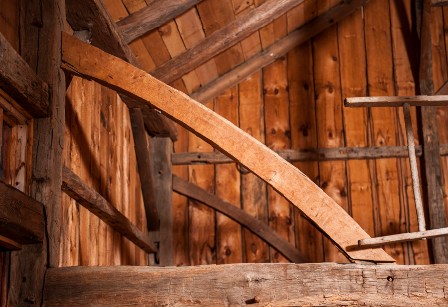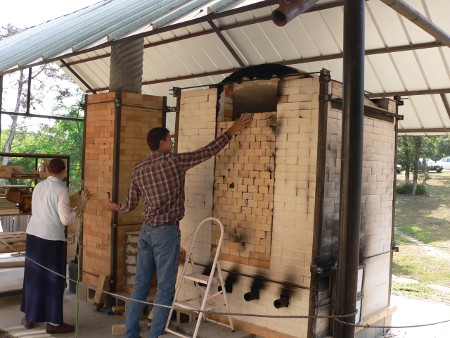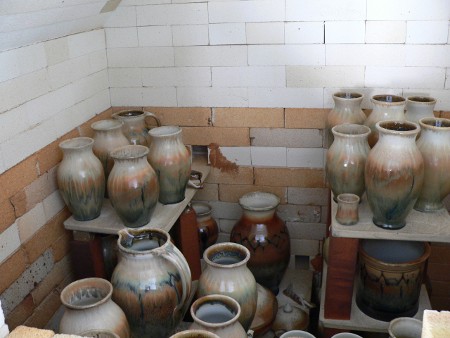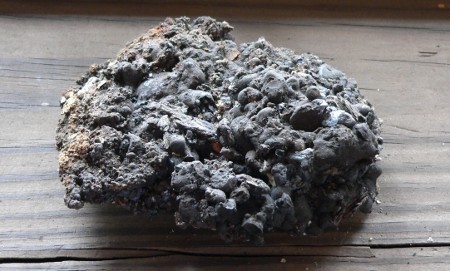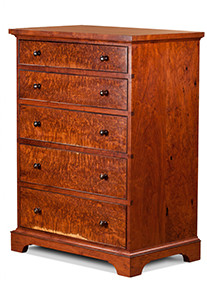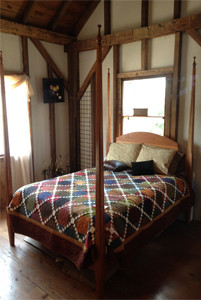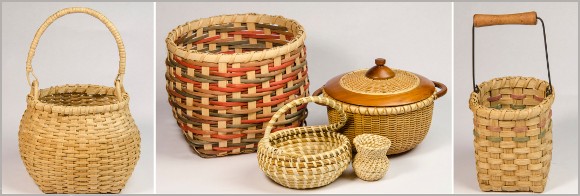
Growing up, there were baskets all over our house—decorating the walls; filled with balls of yarn, toys or books; tucked into nooks and crannies on the shelves. My mom collected baskets, and often when she went out, she would come home with yet another beautiful basket. Although I enjoyed doing a wide variety of crafts, such as sewing, knitting, crocheting and cross-stitching, the thought of weaving a basket had never occurred to me. It wasn’t until I started looking for something new and different to make for my best friend’s birthday that I had the idea to weave a basket. She was newly engaged, and I wanted to make her something for her new life, so I wove her a Shaker cat-head basket and filled it with cloth napkins and several other gifts. I thought making a basket would be a fun, one-time project, but after that, I was hooked. I read basketry books, ordered supplies and jumped straight into basketry, not knowing where it would lead.
Although baskets today are often used as decoration, for thousands of years baskets served as useful containers; and having been custom-made for specific functions, they filled many needs in people’s daily lives. Newborn babies slept in hand-woven cradles or bassinets. Children gathered freshly laid eggs into egg baskets which perfectly fit this task. Made with two rounded side pockets, ribbed egg baskets allow the eggs to gently nestle together so they don’t jostle around and break. Wicker hampers and laundry baskets held the family’s laundry.
Field baskets of all sizes were perfect for harvesting crops ranging from green beans to cotton. People walked to local markets to shop, carrying their goods home in market baskets. Picnic baskets with lids were ideal for transporting the family’s Sunday meal for “dinner-on-the-grounds” after church. Dough rising baskets left their pattern imprinted on finished loaves of bread, and once removed from the oven, the hot, crusty loaves were served in bread baskets. Fishermen tossed their catches of fish into wicker creels slung over their shoulders, and some still do so today. Lining the creel with moss and then dampening the moss allowed the fisherman to keep his catch cool all day [1]. Using basket making skills and materials, people fashioned sandals, fences and even dwellings. Whatever needed carrying or storing, people would make a basket to fit the need—backpack baskets, totes with woven handles and even tightly woven baskets for hauling water. Ancient baskets even served as the forms on which clay vessels were shaped. It’s only more recently that baskets have found their primary place on the wall or the shelf as a decoration.
Traditionally, people crafted baskets from materials that grew locally. Indians in Florida, Louisiana and Texas stitched coils of pine needles together with fern roots or swamp grass; whereas Indians in New Mexico coiled bunches of Sacahuista (Nolina microcarpa), stitching them together with yucca to form sturdy, functional baskets. White oak trees grew plentifully in the Ozark and Appalachian Mountains where basket makers would search for and select the “perfect” tree for pulling splints to weave into apple baskets, egg baskets, pie baskets, market baskets and many others. In northern states such as Maine, New York and Massachusetts, basket makers would make splints from logs cut from Brown Ash or Black Ash trees. Honeysuckle vines, grapevines, wisteria vines, cattails, climbing okra vines, corn husks, willow, rattan palm and bamboo are just a few of the many natural materials that you can harvest, prepare and craft into useful baskets. When harvesting natural materials, one rule of thumb is that if you can wrap a green vine around your wrist without it snapping, it is flexible enough to use for handles, spokes and the basic framework of a basket. A vine that is flexible enough to wrap around your finger without breaking will work well as weaving material.
Knowing when and how to harvest and prepare local, natural materials and weave them into a basket takes skill. Traditionally this know-how was passed down from previous generations. Children easily learned these skills because basket making was a way of life. I learned to make baskets from books because I knew of no one at the time who made or even knew how to make baskets, though I’ve met a number of basket makers since then. That was several years before I married and had my first child. Later, while my children were still young, I made quite a few baskets and taught classes to children and adults. As I wove baskets, my children would watch and play with the scraps, fashioning them into their own “baskets” and other interesting structures. One day, when I had been weaving a ribbed egg basket, I put it down for a moment to attend to something else, and my oldest daughter, who was almost four years old, picked it up and began weaving. To my surprise, she wove several rows quite well without any help or prior instruction. As she grew older she continued to make baskets and helped teach others.
Soon after I had made my first basket, I became interested in weaving baskets from local materials, so I started reading anything I could find about that. We found a few articles on honeysuckle, so we went in search of honeysuckle vines. Books said honeysuckle grew on the ground in long straight runners, but the only honeysuckle vines we found grew all over fences in tangled, gnarled clumps. Undeterred, we pulled, cut and hauled home masses of vines. The instructions I had read said to boil the vines for four hours, then strip the bark and soak the vines for another thirty minutes before using. That sounded simple enough, so we boiled the first batch in a water bath canner on the kitchen stove. At first, the smell was pleasant, but after four hours of boiling, the smell wasn’t nearly as pleasant. (After that lesson, we boiled our honeysuckle vines outside.) We took the boiled vines, still curly even after boiling, and twined them into round baskets that looked rustic and primitive but were strong and sturdy. These were my mom’s favorite baskets. We felt a joyful sense of accomplishment at having made baskets from what we had harvested ourselves, and this inspired us to look for and use other materials. The whole thing was quite an adventure—those times of being entangled in honeysuckle vines as I worked together with my mom and sisters to pull the vines free, or the times when I took my class of young basketry students to harvest grapevines. Most of the children in the class were small, and as they tugged on the thick grapevines hanging from trees, they would invariably end up swinging in the air instead of freeing the vine. Peals of laughter would fill the air, and we all had a good time.
We learned to make pine needle baskets, too. The pine needles that grew near us were short, but driving back home to Texas from a trip we had taken to the East Coast, we passed through Louisiana after a bad storm, and there were branches of nice long pine needles lying all along the sides of the highway. We stopped and searched the car for as many empty bags as we could find, then stuffed them full of fallen pine needles. Once we got home, we spread the fresh green needles on our front porch to dry. Later, we stitched them into coiled baskets and coasters.
Shortly after I had made my first basket, I started teaching basketry classes for children. Martha May was one of my students, who started making baskets when she was fourteen years old. From the beginning, she showed a strong interest in basket weaving and did well with it. After a few years she began to help me teach, and now she is The Ploughshare’s main teacher of basket classes, along with teaching classes to children and adults in our community. She has made many beautiful baskets and continues to broaden her horizons, making sandals out of canna lily leaves and raffia, cradles for infants and beautiful pine needle baskets that are sold in our fine crafts gallery.
Basket making is a skill nearly anyone can learn, and you can take basketry to any level you desire—from making simple, functional baskets that you can complete in a few hours to making finely crafted masterpieces that take days or even weeks to complete.
References:
[1] Wikipedia – Creel (basket).

